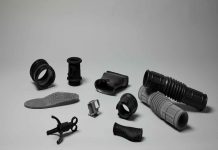
A team of scientists from Bristol University have developed a new process of 3D printing that involves using ultrasonic waves to position millions of fibers inside an object.

Image courtesy of Matt Sutton, Tom Llewellyn-Jones and Bruce Drinkwater © 2016
This new process is actually a new way to 3D print high-tech composite materials such as carbon fiber composites that are used to produce lightweight but very durable and strong products such as aircraft parts, aerodynamic bikes and tennis rackets.
The scientists presented their novel method in a study which was recently published in Smart Materials and Structures.
As mentioned above, this new technology involves using ultrasonic waves to position millions of fibers inside an object during the 3D printing process.
“The fibres are formed into a microscopic reinforcement framework that gives the material strength. This microstructure is then set in place using a focused laser beam, which locally cures the epoxy resin and then prints the object,” the scientists state.
“To achieve this, the research team mounted a switchable, focused laser module on the carriage of a standard three-axis 3D printing stage, above the new ultrasonic alignment apparatus.”
The system itself was developed by Tom Llewellyn-Jones, a PhD student at Bristol University.
“We have demonstrated that our ultrasonic system can be added cheaply to an off-the-shelf 3D printer, which then turns it into a composite printer,” said Mr Llewellyn-Jones.
“Our work has shown the first example of 3D printing with real-time control over the distribution of an internal microstructure and it demonstrates the potential to produce rapid prototypes with complex microstructural arrangements. This orientation control gives us the ability to produce printed parts with tailored material properties, all without compromising the printing,” added Bruce Drinkwater, Professor of Ultrasonics in the Department of Mechanical Engineering.
According to them, this novel ultrasonic technology is still in its early stages; however, great advances are expected in the next few years.
“As well as offering reinforcement and improved strength, our method will be useful for a range of smart materials applications, such as printing resin-filled capsules for self-healing materials or piezoelectric particles for energy harvesting,” concludes Dr Richard Trask, Reader in Multifunctional Materials in the Department of Aerospace Engineering.


















